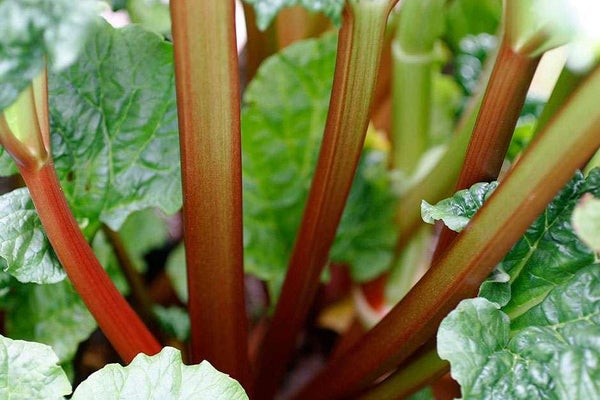
Getting Started
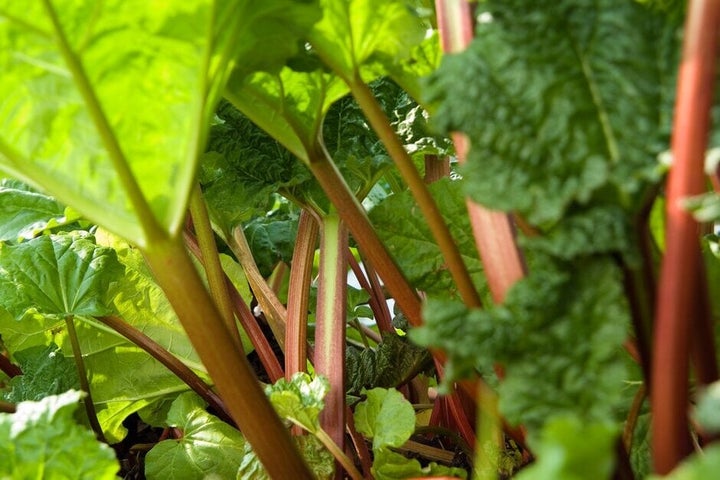
Rhubarb (Rheum × hybridum) is a hardy that lives for many years and thrives in even the coldest sites. It’s low maintenance and extremely easy to grow. It does require plenty of space though, as it will form a large leafy clump 1.5m (5ft) wide or more. Its red-tinged stems and large green leaves die down over winter, with new growth emerging in spring.
The leaf stalks are usually picked during spring and early summer, but plants can be covered with large pots or jars in winter to produce an early crop of delicious blanched stems. The flavour of rhubarb varies in sweetness depending on the age of the stems and the variety.
Some initial patience is required, as you shouldn’t harvest any stems in the first year after planting, and only a few in the second, to allow the plant to get well established. In the third year, you can harvest normally, taking up to a third of the stalks at any one time.
Rhubarb is a vegetable rather than a fruit, but it's traditionally eaten as a dessert, baked in pies and crumbles. Although you can use it in many more ways, including tangy chutneys and savoury sauces.
Jobs to do now
Plant
Month by Month
Plant
Harvest
Choosing What To Grow
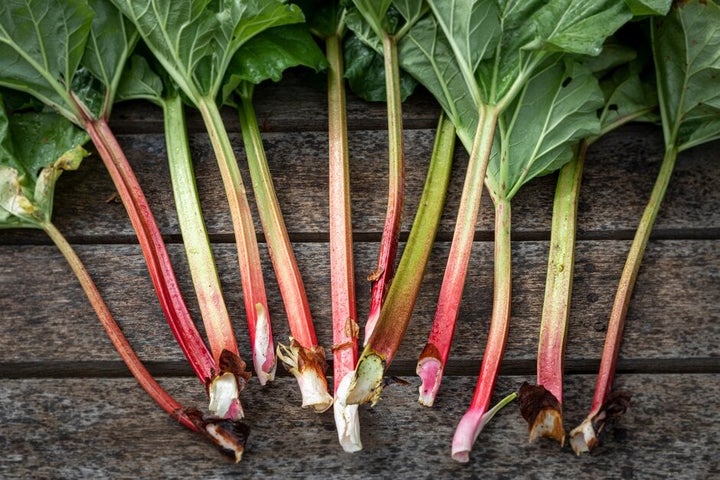
There are many varieties of rhubarb, with leaf stalks of various reddish hues, from rich ruby to pale pink or blush-green. Flavour, sweetness, vigour and harvesting time can vary between varieties too. Choose a more compact variety for growing in a container, and an early cropper for in winter.
Varieties with an RHS Award of Garden Merit (AGM) performed well in RHS trials – see our list of AGM fruit and veg (135kB pdf) and our Recommended Varieties below. RHS Garden Bridgewater holds the National Plant Collection of Rheum × hybridum cvs. (culinary) with over 100 varieties of rhubarb, many of historical interest – visit in spring or summer to see the different varieties. You can also see a wide range of vegetables and fruit in all the RHS gardens, so do visit for lots of inspiration and growing tips.
What and where to buy
Rhubarb can be grown from seed, but is more often bought as young plants – either as plants (crowns) from autumn to early spring, or as potted plants. Plants and seeds are available from many gardening retailers, but bare-root crowns are mainly sold by mail order. Always buy from reputable suppliers to ensure healthy, virus-free plants. Bare-root rhubarb crowns are cheaper than plants in containers, but are only available during the dormant season. Seeds are an even cheaper option, but take much longer to reach cropping size.
Before buying, it’s also worth asking fellow gardeners if they have any rhubarb plants to spare. Established clumps should be divided about every five years, in late autumn or winter, to keep them cropping well. This process produces several new plants each time – ideal for sharing with friends.
Recommended Varieties


‘Fulton’s Strawberry Surprise’ AGM
Bright red stems and good, balanced flavour. Ready to harvest in May and June.

'Raspberry Red' AGM
Produces sweet bright red stems without the need for forcing. Heavy cropper from April.
Preparing The Ground
Rhubarb grows best in an open, sunny site with fertile, moisture-retentive soil that doesn't get . It will also cope in light shade. If your soil is heavy clay and/or has poor drainage, plant in raised beds or large containers. Although rhubarb is very hardy, it’s best not to plant it in a site prone to late frosts, as the young stems may be damaged. Late-cropping varieties are a good choice for cold sites.
Prepare the planting site by removing weeds, then dig in two bucketfuls of well-rotted organic matter, such as homemade garden compost, per square metre/yard. Alternatively, if you're practicing no-dig, the soil with organic matter ahead of sowing or planting directly into the mulch.
Sowing
Growing rhubarb from seed is not the easiest or quickest option, but it's the cheapest way to produce lots of plants. Seed-raised plants are slower to get established than rhubarb bought as or potted plants, which already have strong roots. They are also more variable in quality, as bought plants are produced by division so are exact of their parent.
If you decide to grow rhubarb from seed, sow indoors in late winter. Sow seed 2.5cm (1in) deep into filled with peat-free . Plant out in late spring or autumn. Alternatively, sow outside in spring, into a prepared at a depth of 2.5cm (1in). Thin to 15cm (6in) apart, with further and transplanting of young plants to their final spacing of 75–90cm (30–35in) apart.
Planting
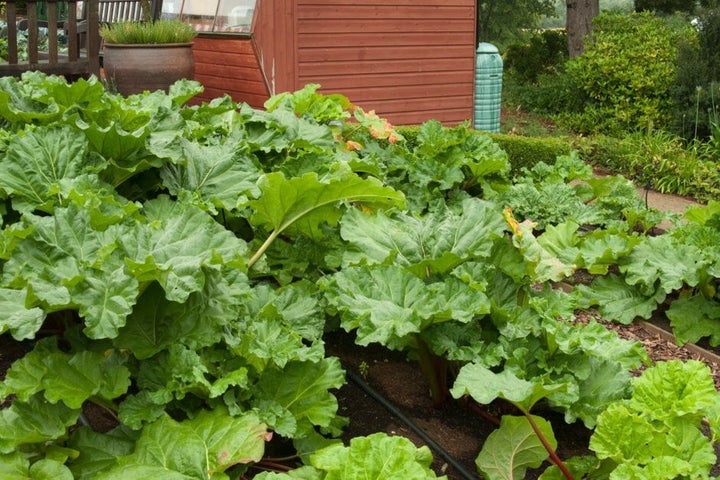
Rhubarb can be bought either in pots or as plants known as crowns. Both are planted in a similar way, although the timing may vary:
- Container-grown plants – are sold all year round for planting at any time, although spring or autumn are best. Avoid planting in very hot, dry weather
- Bare-root crowns – are generally available from November to March and should be planted soon after you receive them
Dig a planting hole that’s just a little wider than the root system. Position the plant so the tip of the crown, or the point where the leaves emerge, is just above the soil surface. Back-fill around the roots with soil, firm in, then water well. If planting more than one, space them 75–90cm (30–35in) apart. For more planting tips, see our guide below.
Planting in containers
If your soil gets in winter, or you’re short on soil space, you can grow rhubarb in a large container. Choose a pot at least 50cm (20in) deep and wide, and ideally select a compact variety of rhubarb. Make sure there are plenty of drainage holes and choose a peat-free . Position the plant so its main growth or the point where the leaf stalks emerge is just above the surface. Be prepared to water regularly during spring and summer.
Plant Care
Once established, rhubarb needs little maintenance, apart from removing flower stems and faded leaves, and in spring. Clumps should also be divided once they become overcrowded. For a crop of early, sweeter stalks, you can force (or blanch) them in winter.
Watering and feeding
Once established, rhubarb rarely needs watering, but young plants and those in containers do need regular attention:
- Newly planted rhubarb – water regularly during dry spells throughout its first growing season, until well rooted
- Established rhubarb plants – water only during prolonged dry periods in summer. Growth will slow down and even stop if conditions are too hot and dry
- Rhubarb in containers – water regularly throughout the growing season, as the will dry out quickly. Keep it moist but never . Waterlogged compost can lead to roots rotting
(see below) should provide sufficient for rhubarb to grow well. If you have poor soil and growth is slow, applying a high-nitrogen, organic-based fertiliser, in spring or summer, will boost growth.
Mulching
Every spring, apply a mulch of well-rotted organic matter, such as homemade garden compost, in a layer about 7cm (2½in) deep around rhubarb plants, but take care not to bury the crown, as that could cause rotting. helps to retain moisture in the soil and suppress weed growth.
Forcing rhubarb
Earlier harvests of sweeter, tender, pale stalks can be produced by covering rhubarb plants with a jar, tall bucket or dustbin in mid-winter, so the stems form in the dark. Choose an early variety, such as ‘Timperley Early’, and only use a strong, healthy plant. Once stalks appear, they will grow quickly so check them regularly. They'll be ready to harvest four to eight weeks after being covered.
After you have harvested the first flush of forced stems, remove the covering and allow the plant’s subsequent stems to develop normally. Avoid forcing the same plant in consecutive years. For more information on forcing rhubarb, see our guide below.
For an even earlier harvest, lift some roots in November. Ideally leave the lifted roots outside for up to two weeks, to expose them to more cold - this is needed to overcome . Then pot up with peat-free multipurpose and bring into a cool room or greenhouse at a temperature of between 7-16ºC (45-60ºF). Exclude light with buckets and keep the roots only slightly moist. Stalks can usually be harvested in five weeks. Crowns forced in this manner are significantly weakened and usually discarded after harvest.
Removing flowers
Rhubarb clumps might produce flowering stems in spring and summer, these should be removed at the base as soon as they appear, to prevent them weakening the plant.
It is believed that some varieties are more prone to flowering than others, and that seed raised rhubarb may have a higher likelihood of flowering. Flowering is more common in a wet summer or if a high nitrogen feed has been overused. Also, older plants that haven't been divided for many years are more likely to flower.
Dividing mature plants
Large clumps of rhubarb should be divided every five years or so, especially if the leaves are overcrowded or growth has become weaker. This will give you several vigorous new plants for your own garden or to share with friends, but only propagate from strong healthy plants to ensure they are virus-free. Dig up the entire clump while , between mid-autumn and early spring. Use a spade or an old kitchen knife to slice it into several smaller sections, each with a portion of the rhizome (thickened underground stem) and at least one growing point ( ). Sections from the outer part are better than the centre of old plants. Discard any weak or decayed parts. Replant the sections straight away or wrap them in damp sacking for a short time if necessary.
Overwintering
Rhubarb is hardy and needs no protection over winter. In fact, exposure to cold is necessary to trigger new growth in spring. In autumn, allow the leaves to die back naturally, then cut or pull them all away to expose the growing points to winter cold. The faded leaves can be added to the bin – there’s no need to worry about the poisonous oxalic acid they contain, as this breaks down during decomposition.
Harvesting
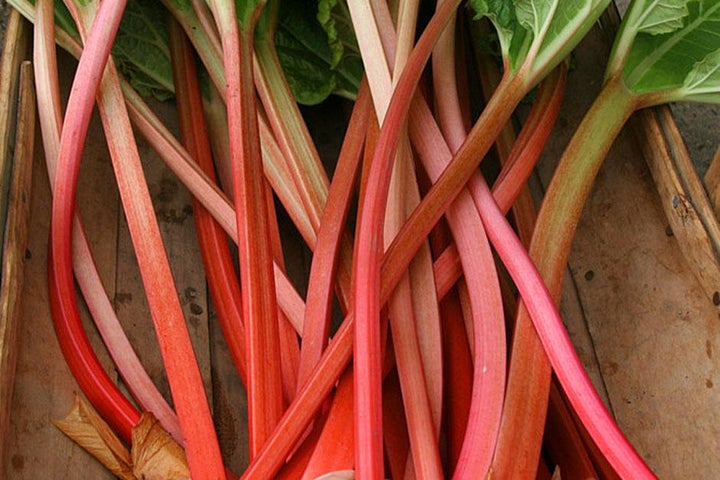
With newly planted rhubarb, resist the temptation to harvest any stalks in the first year, as this will reduce the plant’s vigour. The following year, pick just a few. After that, the plant should be well established and can be harvested normally.
Most varieties can be harvested from April or May. Although the stems can remain edible and tasty through summer, it’s best to stop harvesting in late June or early July, or at least only take a few stalks from established clumps after then, so you don’t weaken the plant.
To harvest, choose a young stalk about 30cm (1ft) long, with a leaf that has only just fully opened. Hold the stalk at the base and twist gently to ease it out of the ground. Try to avoid snapping it off, and don’t cut it, as you’ll leave a stump that is prone to rotting. Then remove the leaf, which is not edible, and add it to your compost bin. Only ever take about a third of the plant’s stems, so there are plenty of leaves left to keep it in active growth.
Stalks of forced rhubarb are also harvested when they reach about 30cm (1ft), this may take four to eight weeks after covering. After harvesting all the forced stalks, remove the covering to allow light to reach the crown, and don’t harvest any more stalks from that plant until the following year.
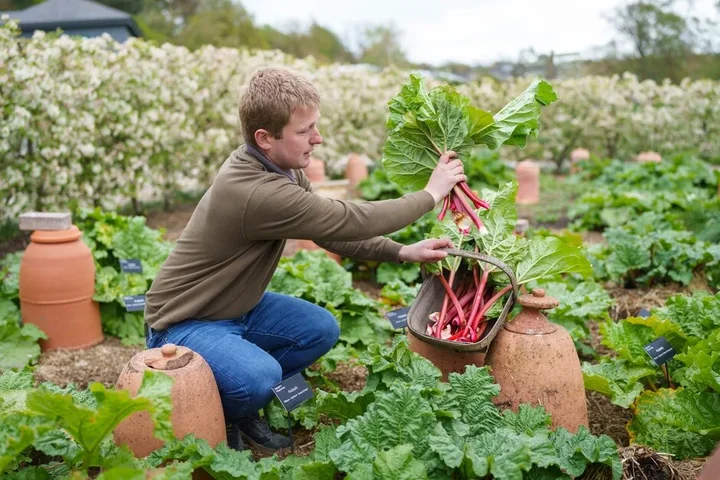
TOP TIP
Some people worry about increasing levels of oxalic acid in rhubarb as the season progresses. However, this build-up is mostly in the leaves, which you don’t eat, and the amount in the stems is insufficient to have a toxic effect.
Problem Solving
Rhubarb is generally a robust, hardy and healthy plant that can live for at least ten years, and can be kept going far longer if divided regularly. However, there are some potential problems to look out for:
- Slugs and snails may damage young shoots, especially tender shoots under jars
- Late frosts can damage young shoots, so cover with straw or biodegradable fleece if freezing temperatures are forecast
- Rotting in damp conditions, especially in winter – avoid planting rhubarb in a poorly drained site that gets , and make sure plants in containers don’t sit in trays of water. If you notice areas of die-back, cut these out promptly before the rot spreads and kills the whole plant
- Split stalks, sometimes exuding sticky – this may be caused by late frosts but is often an indication of erratic growth due to fluctuations in growing conditions. Cool or dry periods followed by moist or mild weather means the outer growth splits when the new, rapid growth occurs
For more details on spotting and tackling issues that may affect your rhubarb plants, see Common problems below.
Common Problems

Plant viruses
Plant viruses affect many plants and cause a wide range of discolourations and distortions in leaves, shoots, stems and flowers, but rarely kill the p...

Slugs and snails
Slugs and snails are common garden animals, and they are well suited to the damp, mild climate of the UK. A few species feed on garden plants, but mos...



